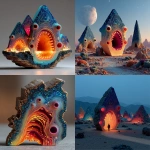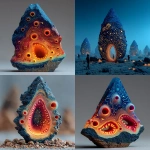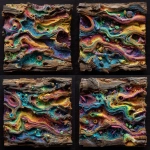Explore the Best AI Image Gallery

Beyond the Canvas: How Edge Computing is Transforming Creative Industries
The creative landscape is undergoing a seismic shift, fueled by the rise of innovative technologies. One such game-changer is edge computing, a paradigm that brings processing power closer to data sources – a concept with profound implications for artists, designers, and creators across various disciplines.
Edge Computing: A Primer
In essence, edge computing distributes computational tasks across a network of devices, rather than relying solely on centralized cloud servers. This decentralized approach offers several advantages:
- Reduced Latency: Processing occurs in real time, minimizing delays and enabling seamless interactive experiences.
- Enhanced Data Security: Sensitive creative data remains closer to its source, reducing the risk of breaches during transmission.
- Increased Bandwidth Efficiency: By processing data locally, edge computing reduces the strain on bandwidth, freeing up resources for other applications.
Edge Computing Applications in Creative Industries
The potential applications of edge computing in creative fields are vast and constantly evolving:
1. Immersive Art Installations
Imagine interactive art installations that respond to viewer movements and emotions in real time, powered by edge-enabled sensors and AI algorithms. This creates truly immersive and personalized experiences for audiences.
2. Real-Time Collaborative Design
Edge computing can facilitate seamless collaboration among designers working remotely on the same project. Changes made by one designer are instantly reflected for others, fostering a more fluid and efficient workflow.
3. AI-Powered Creative Tools
Edge devices can host powerful AI models that assist artists in generating ideas, refining designs, or even composing music. This opens up new possibilities for creative expression and exploration.
4. Personalized Content Creation
Edge computing enables the creation of personalized content tailored to individual preferences. Imagine a digital gallery where artworks adapt to your mood or artistic style, providing a unique viewing experience.
Ethical Considerations
As with any transformative technology, edge computing in creative industries raises important ethical considerations:
- Data Privacy and Security: Safeguarding sensitive user data collected by edge devices is paramount. Robust security measures and transparent data usage policies are essential.
- Algorithmic Bias: AI models used in creative tools must be carefully trained to avoid perpetuating biases that could result in unfair or discriminatory outcomes.
- Intellectual Property Rights: The use of AI for content creation raises questions about authorship and intellectual property ownership. Clear guidelines are needed to address these complexities.
Future Trends
The future of edge computing in creative industries is bright, with several exciting trends on the horizon:
- Increased Integration with AR/VR: Edge computing will enhance immersive experiences by enabling real-time interactions within augmented and virtual reality environments.
- 5G and Beyond: The rollout of faster 5G networks will further accelerate the adoption of edge computing, facilitating seamless data transfer and real-time collaboration.
- Democratization of Creativity: Edge-enabled tools will empower individuals with limited technical expertise to participate in creative processes, fostering greater accessibility and inclusivity.
Edge computing is poised to revolutionize the creative landscape, empowering artists, designers, and innovators to push boundaries and explore new frontiers. By embracing its potential while addressing ethical considerations, we can unlock a future where creativity knows no limits.



](https://images.ai-img.art/thumbnails/150/914cb18c03c97bdba2f290c0ec1573d5792bf399dbad7f484614764eb31f4c2f.webp)







](https://images.ai-img.art/thumbnails/150/98325fa7102e81df81f1dba6df8df52929b4fa41b058192faf3c77cf94513ff7.webp)
](https://images.ai-img.art/thumbnails/150/09314c003088f7174f747fa65105eca599e0842cf69e637ce4c98ebefd3f50ab.webp)

](https://images.ai-img.art/thumbnails/150/3b65287fef447a6ad61bcb18b5b9d03b6f6f74603ae0e058f81f4b91a3e02f36.webp)







](https://images.ai-img.art/thumbnails/150/ac7218edd6198d49ed8d9853a5890595fc4d2a7a11c2e8a7ee8bcfbc7bfe265e.webp)












](https://images.ai-img.art/thumbnails/150/a31f622763ce0ecb2e76a907e566b81cfcc171e8d9b8b393f27681be24b6ca91.webp)

](https://images.ai-img.art/thumbnails/150/769518185300fcbda91b7bbf92b9007bc856379accd52eaf7983f9aec379e88e.webp)






](https://images.ai-img.art/thumbnails/150/7d9de60c58579b921ad140a9e1d752642452d5086b74a27d866e8af04608ed7d.webp)
](https://images.ai-img.art/thumbnails/150/ebc95932b25c17607076ed8d2a4bafc85c3371cf3f2d45c35741505fe3c97de1.webp)



